Intersections
When making a right-hand turn at the intersection shown, you must give way to:
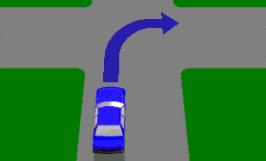
Which statement is correct?
When approaching a railway level crossing displaying this sign, you must:

You are in car A and are going straight ahead through the intersection. Who should give way?

You drive up to an intersection with a stop sign. There is no painted stop line. Where should you stop?
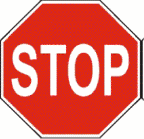
You wish to go straight ahead at this roundabout. Which statement is true?

The motorcyclist wants to travel straight ahead through this roundabout. The rider should watch out for the marked car because the car:

The red car wants to turn right and exit the roundabout in the street indicated by an arrow. Is the car positioned in the correct lane to do this?
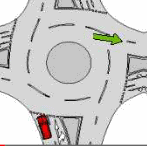
You wish to go straight ahead on this roundabout with two lanes. Which lane may you use?
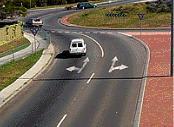
To turn back into the same road from which you joined this roundabout you must:
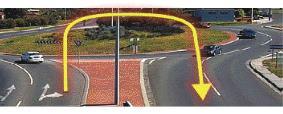
You are driving the car in the diagram. You must stop:
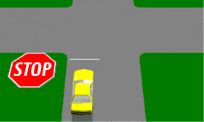
You are in the right hand lane and are planning to go straight ahead through this roundabout. When should you signal left to exit the roundabout?

When turning left at a roundabout you should enter and leave the roundabout:

There are no traffic signs or signals at an intersection. If you intend to drive through the intersection, you must give way to:
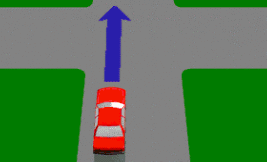
You wish to turn left here. The pedestrian lights are flashing red. You should:
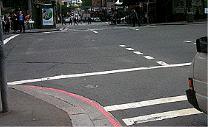
When you wish to drive straight ahead at a roundabout you may enter from either the left or right lane. As you continue around you should:

As you drive into an intersection, the lights turn to yellow. You should:
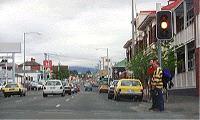
Right-turns must be made from which lanes when travelling on a laned roadway?
When you come to an intersection and the road beyond is choked with vehicles going in the same direction, what should you do?
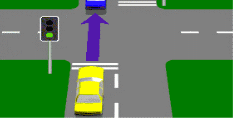
In this roundabout with two lanes, can the marked car turn right?
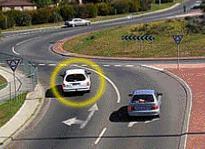
You want to turn left at this roundabout. Which lane must you use?

In this diagram both vehicles O and P must pass through GIVE WAY signs before entering the intersection. Which vehicle goes first?
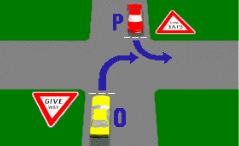
Which vehicle in the diagram must give way?
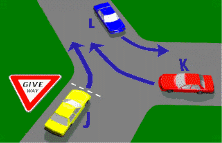
You want to make a left turn. You must use your left-hand indicator
What should you do on approaching a railway level crossing displaying a STOP sign?

If a STOP or GIVE WAY sign has been knocked down, for example, as the result of an accident, does the line marked across the road have any meaning?
If the boom gates are down and the signals are flashing, at a railway level crossing, you may begin to cross:
If turning right at a T-intersection (as shown) must you give way to vehicles approaching from both the left and right?

If both vehicles P and O in the diagram are turning right, which vehicle is in the best position to turn left into the street marked 'X'?
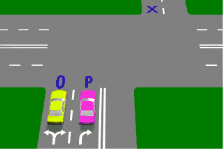
When police officers are at intersections giving directions you must:
You wish to make a right-hand turn from a ONE WAY STREET with no arrows marked on the roadway. You should position your vehicle:
When there are no arrows marked on the road, left turns must be made from:
You are in the car approaching the intersection shown, you should:

If you enter an intersection that is under the control of a traffic controller:
The traffic on the other side of this intersection has stopped. You are in the car shown and want to cross the intersection. The lights are green. What should you do?
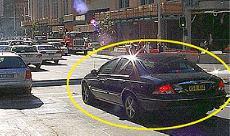
This intersection does not have any traffic lights or signs. You are in car A and want to turn right. When can you go?
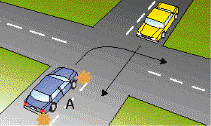
You wish to turn left at this roundabout. Which lane may you use?

When you wish to turn left at a roundabout you indicate:
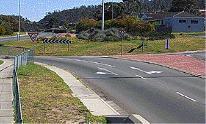
You approach an intersection in busy traffic and want to go straight ahead. The traffic lights turn green. When are you permitted to enter the intersection?

At the T-intersection shown in the diagram which vehicle should give way?
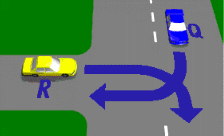
If turning at an intersection are you required to give way to pedestrians?
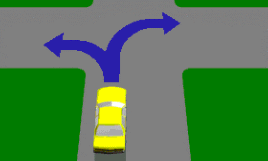
Even if the signal at a railway level crossing does not indicate that a train is coming, you should:
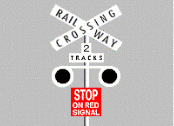
You are at a busy intersection with slow moving traffic and want to go straight ahead. When the traffic lights change to green you should make sure that:
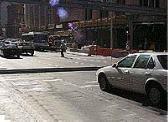
You drive up to an intersection with a stop sign in the car marked A and you wish to turn right. The car marked B facing you also has a stop sign and is indicating to turn left. Who can go first?
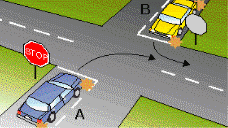
A GIVE WAY sign at an intersection means that you must:

The diagram shows a marked pedestrian crossing at an intersection. There is also a STOP sign at the intersection. You have already stopped for a pedestrian. Must you stop again at the STOP line?
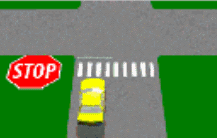
Vehicle O is at a STOP sign

You are in car A and want to turn right at this intersection. Car B facing you is also indicating to turn right. What path should you take?

You come to an intersection in Sydney with a Light Rail vehicle about to enter. What should you do?

You are at an intersection and see a pedestrian crossing the road into which you are turning. You must:
When these lights are flashing it means
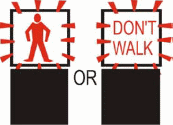
At this intersection there are no signs or traffic lights. You are in the car marked A. You want to turn left. What should you do?

As you approach an intersection, you should check for traffic on your left and right:
You come to an intersection that does not have traffic lights or signs. How do you decide when to drive straight ahead?
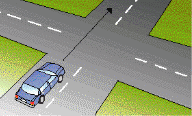
Not enough to pass :-(
You have answered 0 correct out of 54 question(s).
What's Next?
Review your answers
See which answers you chose and what the correct answers are.
Study Guide
Review all the correct answers.
Question: {counter}
{question}
- {options}
